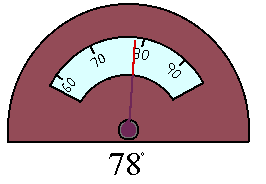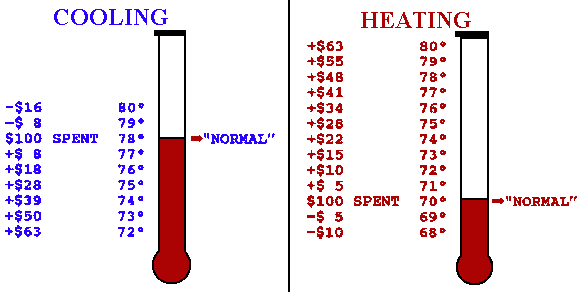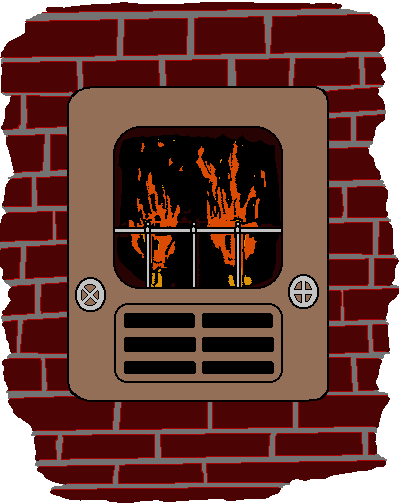ADJUST YOUR THERMOSTAT
- GOAL:
- The student will realize the importance of proper thermostat setting in order to save energy.
- OBJECTIVES:
- The student will be able to:
- 1. Explain the role of the thermostat in temperature and humidity control.
- 2. Describe the suggested thermostat settings for maximum energy savings.
- 3. List other methods of saving on heating and cooling costs.
- LESSON / INFORMATION:
- Heating and cooling costs account for about 50% of the home energy budget. An ideal way to cut down on energy use and utility bills would be to reduce energy used for heating and cooling. There is a simple, easy, no-cost method of doing just that -- ADJUST YOUR THERMOSTAT!
- In Louisiana it is likely that more money is spent on cooling during the hot summer months than is spent heating during the mild winter months.

- In the summer, the thermostat should be set no lower than 78°F to 80°F. For every degree the thermostat is raised, 4% to 8% can be saved on cooling costs.
- EXAMPLE:
- With the thermostat set on 72°F, a family's July utility bill is $120.
- (a) How much was spent on cooling?
- 50% of the bill was spent on cooling
- 50% x $120 = $60 was spent on cooling
- (b) At a savings of 4% per degree, how much could be saved if the thermostat was raised to 78°F?
- 4% x 6° = 24% savings
- 24% x $60 = $14.40 saved
- (c) At a savings of 8% per degree, how much could be saved at 80°F?
- 8% x 8° = 64% savings
- 64% x $60 = $38.40 saved
- ACTIVITY 1:
- Now assume your family had a $225 August utility bill. Answer the following questions using the example above.
- a. At 72°F, how much was spent on cooling?
- b. At a 4% per degree savings, how much is saved at 78°F?
- c. At a 8% per degree savings, how much is saved at 80°F?
- During the summer it is important to keep the thermostat protected from heat and sunlight so as not to overwork the unit. It is also helpful to use fans to increase comfort. Increased air circulation helps people feel cooler at higher temperatures, and it helps reduce some of the effects of high humidity. Remember, turn fans off when a room is not in use because fans cool people, not rooms.
- Suggested thermostat settings vary for the winter months. One method is to set the thermostat at 65°F, adjusting upward only if necessary, and never going above 70°F. It is estimated that 4% to 8% of heating costs can be saved for each degree the thermostat is lowered.
- Humidity is another issue that affects comfort in the home. Humidity in the air allows the air to hold more heat. In the summer this excess humidity can make occupants feel warmer and force the air conditioning unit to work harder. In the winter, some heating units tend to dry out the air. This means that the air holds less heat and people feel colder.
- ACTIVITY 2:
- The chart below shows a thermostat set at 78°F in the summer and 70°F in the winter. If $100 is spent monthly for heating or cooling at these "normal" temperatures, how much would be spent at the different thermostat settings of the following four questions?

- Example:
- In the summer, if the thermostat was lowered from 78°F to 75°F, the cooling costs would go from $100 to $128.
- Using the chart above, complete the following calculations. How much money could be saved on heating and cooling bills by making the following adjustments to the thermostat?
- 1. Summer, from 78°F to 72°F?______________________
- 2. Summer, from 78°F to 80°F?______________________
- 3. Winter, from 70°F to 68°F?______________________
- 4. Winter, from 70°F to 78°F?______________________
- While adjusting the thermostat is certainly the easiest way to reduce heating and cooling costs, there are many other ways to help reduce energy waste in this area.
- 1. Turn the heating or cooling unit off on mild days, or when away from home.
- 2. Use timers to turn the unit back on before the family returns in the evening.
- 3. Open windows for natural ventilation.
- 4. Close off unused areas of the house, if central air and heat is not in use.
- 5. Keep doors closed and reduce trips in and out of the house.
- 6. Increase floor, attic, and/or wall insulation.
- 7. Use weatherstripping and caulking where needed to reduce air infiltration.
- 8. Landscape in order to produce shading and wind breaks.
- 9. Choose heating and cooling equipment that is properly sized for the house.
- 10. Keep air filters clean; change every 30 days of use, if needed.

- RESOURCES:
- Baker, Gene. Air Conditioning & Heating with Saving Dollars in Mind. Louisiana Cooperative Extension Service. (Slemco Design One), Louisiana State University, Baton Rouge, LA, n.d.
- Baker, Gene and Peavy, Margaret. Keep Home Heating & Cooling Equipment in Top Shape, Publication 2000 (A-4). Cooperative Extension Service, Louisiana State University, Baton Rouge, LA, n.d.
- Home Management Tips to Cut Energy Costs. Louisiana Department of Natural Resources, Baton Rouge, LA, n.d.
- Homeowner's Energy Conservation. Louisiana Department of Natural Resources, Baton Rouge, LA, 1981.
- INFORMATION CHECK
- Place a "T" in front of the statements that are true and an "F" in front of the statements that are false. Below each false statement explain why it is false.
- _____1. Heating and cooling costs account for about 25% of the home energy budget.
- _____2. Raising your thermostat in the winter and lowering it in the summer can save 4% to 8% per degree on the utility bill.
- _____3. In Louisiana people are more likely to use more energy to cool, rather than to heat, their home.
- _____4. In summer, it is suggested to set the thermostat between 78°F and 80°F.
- _____5. Locating the thermostat out of the sun may keep the unit from overworking.
- _____6. It is important to have humidity in the air during the winter months to prevent drying of skin.
- _____7. Fans are really no help in the summer months.
- _____8. The use of a humidifier will help people feel colder.
- _____9. Adjusting the thermostat is probably the easiest way to reduce energy used for heating and cooling.
- _____10. Raising the thermostat from 72°F to 78°F can save up to $57.60 on a $120 cooling bill.
- _____11. Suggested winter settings for the thermostat vary from about 65°F to 70°F.
- _____12. A mild day is the perfect day to use your heating or cooling system.
- _____13. Closing off unused areas of the house will help the central air and heating unit to run less and thus save on energy costs.
- _____14. You may be wasting money if your heating or cooling system is too large or too small for your house.
- _____15. Air filters should be changed annually to help keep the unit operating efficiently.
- TEACHER'S NOTES
- ACTIVITY 1:
- a. $112.50
- b. $27.00
- c. $72.00
- ACTIVITY 2:
- 1. $163
- 2. $84
- 3. $90
- 4. $148
- DEFINITIONS:
- 1. Humidity -
- This is the amount of moisture in the air. In Louisiana during the summer, excess humidity can make the air seem hotter than it actually is.
- 2. Thermostat -
- This is what controls the heating and cooling system. By setting the thermostat to the desired temperature, it causes the system to operate until that temperature is achieved.
- ANSWERS TO TEST QUESTIONS:
- 1. False - 50% of costs go to heating and cooling.
- 2. False - It is the opposite -- lower the thermostat in the winter and raise it in the summer.
- 3. True
- 4. True
- 5. True
- 6. True
- 7. False - Fans help people feel cooler at a higher temperature; therefore the thermostat can be raised and energy saved.
- 8. False - Humidity makes people feel warmer.
- 9. True
- 10. True
- 11. True
- 12. False - On a mild day, save money by turning the heating and cooling system off.
- 13. False - It is not recommended to close off rooms in homes with central air and heat.
- 14. True
- 15. False - Change the air filter every 30 days, if needed.
Comments or questions to: TechAsmt@LA.GOV
Return to Home Energy Menu



